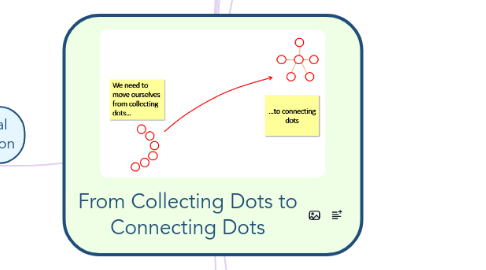
1. Additional information
1.1. Toni Krasnic
1.1.1. Let's connect
1.1.1.1. tkrasnic@gmail.com
1.1.1.2. LinkedIn
1.1.1.3. Twitter
1.1.1.4. Google+
1.1.1.5. Facebook
1.1.1.6. Google+ Mind Mapping Community
1.1.2. Books
1.1.2.1. Concise Learning
1.1.2.2. How to Study with Mind Maps
1.1.2.3. Mind Mapping for Kids
1.1.3. Mind maps
1.1.3.1. Biggerplate library
1.1.3.2. MindMeister library
1.2. Biggerplate
1.2.1. Twitter
1.2.2. #bpun16 Conference
1.2.3. #bpun16 Program
1.3. MindMeister
1.3.1. Twitter
1.3.2. Mind map library
2. Key lessons learned about how students learn
2.1. Traditional educational paradigm
2.1.1. Focus on WHAT students need to learn
2.1.2. Little emphasis, if any, on training students HOW to learn
2.1.3. Stick (test) & carrot (grade and degree) approach
2.1.4. Ken Robinson: Changing Education Paradigms
2.1.5. Seth Godin: Stop Stealing Dreams (What is School For?)
2.2. Students
2.2.1. Focus on exams, not learning
2.2.2. Focus on memorizing information (collecting dots; not connecting dots)
2.2.2.1. Not processing information
2.2.2.2. Not thinking critically
2.2.2.3. Not understanding
2.2.2.4. Not learning
2.3. Academically Adrift by Richard Arum & Josipa Roksa (2011)
2.3.1. Are students really LEARNING in college?
2.3.2. 45% of college students made no significant improvement in critical thinking, reasoning or written communication skills during their first two years of college
2.3.3. After 4 years, 36% showed no significant gains in these so-called "higher order" thinking skills
2.4. Students need to learn HOW to learn
2.4.1. Teaching students HOW to learn is as important as teaching content in promoting lifelong learning
3. BPUN16 mind mapping conference!
3.1. Mind mapping in education
4. Learning & Memory
4.1. Information Processing Model
4.1.1. Sensory memory
4.1.1.1. Last 1/2 second
4.1.2. Short-term memory
4.1.2.1. Last 1/2 minute
4.1.2.2. 7 bits of info
4.1.2.3. Encoding
4.1.2.4. Thinking
4.1.3. Long-term memory
4.1.3.1. Relatively permanent
4.1.3.2. Unlimited
4.1.3.3. Semantic (deep processing)
4.1.3.4. Meaningful learning
4.2. Levels of Processing Model
4.2.1. Shallowly (maintenance) processed
4.2.2. Deeply (elaborately) processed
4.3. GOAL: Deep processing of information through meaningful learning to long-term memory
4.4. “The principle goal of education is to create men who are capable of doing new things, not simply of repeating what other generations have done - men who are creative, inventive and discoverers.” —Jean Piaget
5. Learning strategies that enhance student learning & memory
5.1. Improving Students’ Learning With Effective Learning Techniques by Dunlosky et al. (2013)
5.1.1. Reviewed efficacy of 10 learning strategies
5.1.1.1. Popular with students
5.1.1.2. Evidence of effectiveness
5.1.2. Most effective
5.1.2.1. Practice testing
5.1.2.1.1. Boosts long-term memory (retrieval of key concepts)
5.1.2.1.2. Signals what needs to be "re-learned" (know vs. don't know)
5.1.2.2. Distributed practice
5.1.2.2.1. Practice distributed across time
5.1.2.2.2. Opposite of cramming
5.1.3. Promising
5.1.3.1. Interleaved practice
5.1.3.1.1. Practicing different types of problems across time
5.1.3.2. Elaborative interrogation
5.1.3.2.1. Explain why
5.1.3.3. Self-explanation
5.1.3.3.1. Explain how new info is related to what you already know
5.1.4. Less useful
5.1.4.1. Highlighting
5.1.4.1.1. Focus on terms rather than connections
5.1.4.2. Rereading
5.1.4.2.1. Does not enhance understanding
5.1.4.3. Summarization
5.1.4.3.1. Paraphrasing
5.1.4.3.2. Extensive training needed
5.2. Effective learning strategies (mind map)
6. Using mind maps to enhance learning & memory
6.1. Mind maps visually organize and connect concepts
6.2. Key benefits for learning
6.2.1. Visible thinking
6.2.1.1. YOUR mind map = YOUR understanding
6.2.2. Filtering of key information
6.2.2.1. Separate key concepts from fluff
6.2.3. Connections, not just concepts
6.2.3.1. Notes are just ramblings until they are connected
6.2.4. Scaffolding of knowledge
6.2.4.1. Breadth
6.2.4.2. Depth
6.2.5. Big picture & details
6.2.5.1. Forest
6.2.5.2. Trees
6.2.6. Analysis & synthesis
6.2.6.1. Breaking down into parts
6.2.6.2. Combining into whole
6.2.7. Individual & collaborative
6.2.8. Flexible
6.3. Connect key concepts
6.3.1. Connect new info w/ existing knowledge (elaborative interrogation and self-explanation)
6.3.2. Connect different types of information (interleaved practice)
6.3.2.1. Textbook
6.3.2.2. Lectures
6.3.2.3. Other info sources
6.3.2.4. Practice exams
6.3.3. Mind mapping process for learning
6.3.3.1. Key concepts
6.3.3.2. Connections
6.3.3.3. Critical thinking
6.3.3.4. Key questions
6.4. Build mind maps over time (distributed practice)
6.4.1. Before class
6.4.1.1. Preview
6.4.1.2. Skeleton mind map
6.4.1.2.1. Student
6.4.1.2.2. Teacher
6.4.2. During class
6.4.2.1. Participate
6.4.2.2. Growing mind map
6.4.2.2.1. Student
6.4.2.2.2. Teacher
6.4.3. After class
6.4.3.1. Process
6.4.3.2. Practice
6.4.3.3. Exams
6.5. Test your knowledge (practice testing)
6.5.1. Examples
6.5.1.1. Recreate mind map
6.5.1.2. Hide branches
6.5.1.2.1. Branch 1
6.5.1.2.2. Branch 2
6.5.1.3. Notes, hyperlinks, attachments
6.5.1.4. Practice tests
6.5.1.5. Apply what you've learned to real-world problems
6.5.2. Self-assessment
6.5.2.1. Identify gaps (what you don't know)
6.5.2.2. Correct false knowledge
6.5.3. Self-reflection
6.5.3.1. Learning process
6.5.3.2. Mind mapping process
6.6. Mind mapping + effective learning strategies = Improved learning & memory
7. Getting started with mind maps
7.1. Explore mind maps
7.1.1. Biggerplate
7.1.1.1. ~13 million map views
7.1.1.2. ~100,000 members
7.1.2. Connect with other mind mappers at G+ Mind Mapping community (~2,500 members; ~1,000 posts)
7.1.3. Mind mapping research
7.1.4. Additional resources
7.2. Try mind mapping
7.2.1. Programs
7.2.2. Independently
7.2.3. With peers & teams
7.2.4. Examples
7.2.4.1. School
7.2.4.2. Work
7.2.4.3. Book
7.3. Stay motivated
7.3.1. Autonomy
7.3.1.1. Your choice
7.3.1.2. Self-directed
7.3.2. Value
7.3.2.1. Learning & memory
7.3.2.2. Grades & performance
7.3.2.3. Value to others
7.3.3. Competence (mastery)
7.3.3.1. Practice
7.3.3.2. Learn from others
7.3.3.3. Teach others
